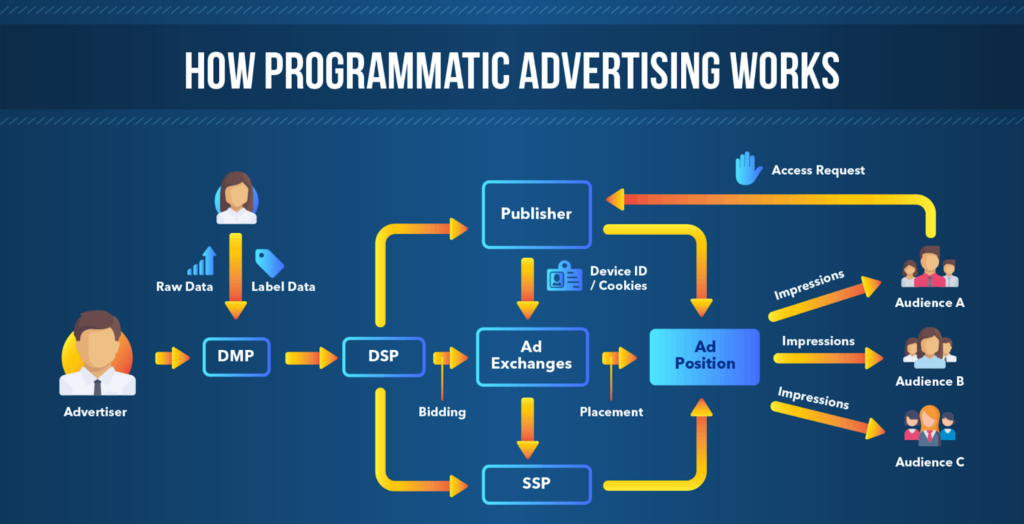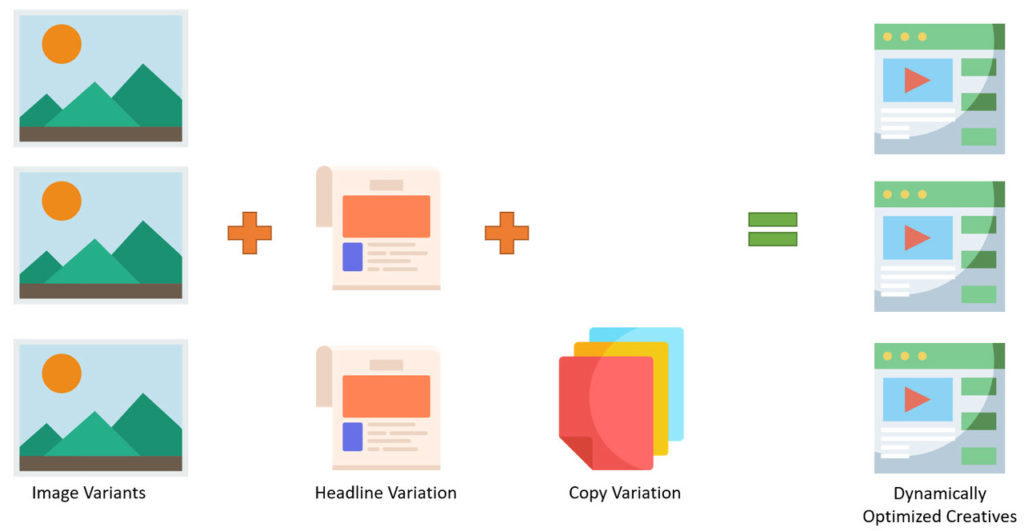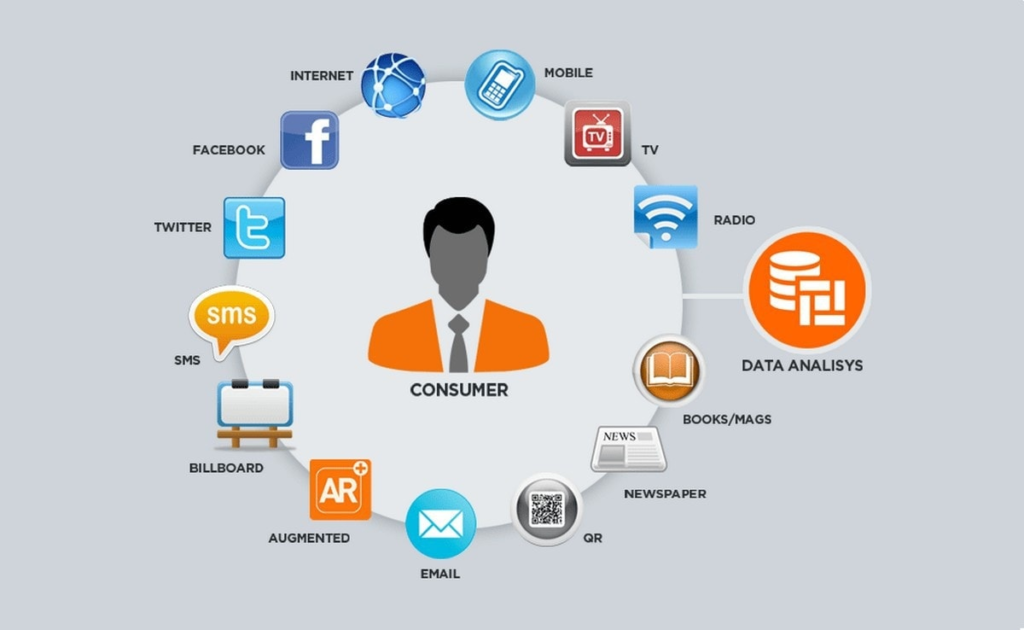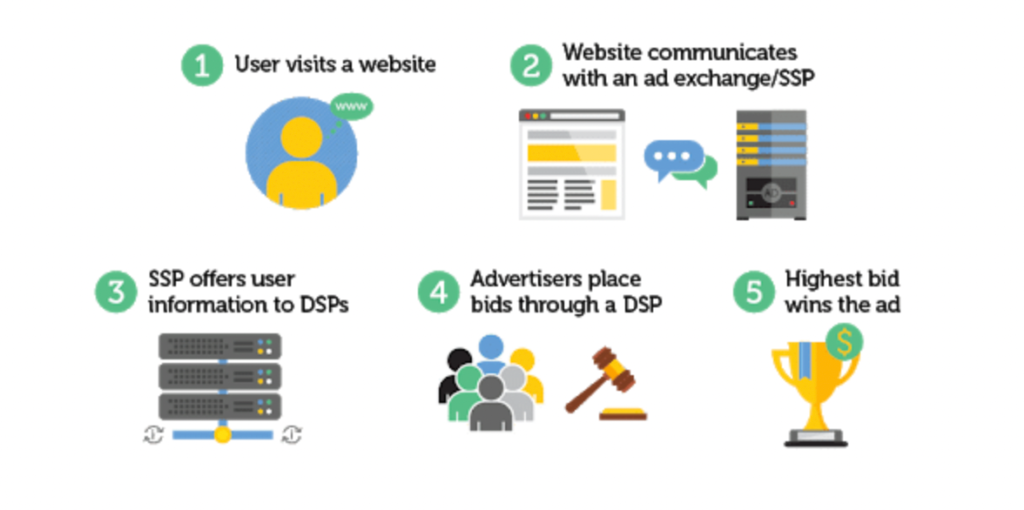In simple terms, programmatic advertising is a fancy way of saying automated ad buying. Instead of the traditional method of buying ad space, where negotiations and manual placements take time, programmatic advertising uses technology to make the process more efficient.
Here’s the gist: computers and algorithms handle the buying of ads in real-time. Think of it as the difference between walking into a store to buy something and ordering it online with just a click. Programmatic advertising works in a similar streamlined fashion.
Importance of Programmatic

Now, why should we care about programmatic advertising ?
Well, let’s break it down. Imagine the internet as a bustling city with millions of people and businesses, all trying to get their messages across. In this digital landscape, programmatic advertising acts as a savvy tour guide.
- Efficiency and Speed: In the fast-paced online world, timing is everything. Programmatic advertising ensures that your ad reaches the right audience at the right moment. No waiting around for manual processes—everything happens in a blink.
- Precision Targeting: Ever notice how ads seem to know what you’re interested in? That’s the magic of programmatic advertising. It uses data to target specific groups of people who are more likely to be interested in what you have to offer.
- Smart Decision Making: Think of programmatic advertising as your marketing assistant. It analyzes data, learns from patterns, and makes smart decisions on where to place your ads for the best results.
II. Understanding Programmatic Advertising
Let’s break down the basics of programmatic advertising and explore the advantages that make it a powerhouse in the marketing realm.

A. Basics of Programmatic Advertising
1. Real-Time Bidding (RTB)
At the heart of programmatic advertising lies Real-Time Bidding (RTB). Imagine a virtual auction where advertisers bid for ad impressions in real-time. Ad spaces are put up for sale, and within the blink of an eye, algorithms assess bids and determine the winning ad. This nimble process ensures that your brand’s message reaches the right audience at the right moment, maximizing the impact of your advertising efforts.
2. Demand-Side Platform (DSP) and Supply-Side Platform (SSP)
To navigate the programmatic landscape, two essential players come into play: Demand-Side Platforms (DSPs) and Supply-Side Platforms (SSPs).
- Demand-Side Platform (DSP): Think of a DSP as your campaign conductor. It’s the tool that empowers advertisers to manage, optimize, and execute their ad campaigns across multiple channels. From setting bid prices to defining target audiences, DSPs provide the controls needed for a successful advertising symphony.
- Supply-Side Platform (SSP): On the flip side, SSPs work in harmony with publishers. These platforms help publishers manage and optimize the sale of their ad inventory. By connecting with DSPs, SSPs facilitate the seamless flow of ads, ensuring that publishers get the most value for their available ad spaces.
3. Ad Exchanges
Enter the digital marketplace known as ad exchanges. This is where the magic happens. Ad exchanges serve as the hub connecting advertisers (via DSPs) and publishers (via SSPs). In this open marketplace, ad impressions are bought and sold in the blink of an eye through RTB. Ad exchanges make the process of matching ads to available spaces both efficient and effective.
Key Strategies for Successful Programmatic Advertising :

Data is your compass, steering you towards the right audience. Let’s unravel two essential strategies that make this data-driven journey not just possible but incredibly effective.
1. Utilizing First-Party Data
Imagine having a treasure trove of insights right at your fingertips – that’s the power of first-party data. These are the details you collect directly from your audience, like website visits, newsletter sign-ups, or app usage. It’s your personalized map to understanding your audience better.
How to make the most of it:
Segmentation is Key: Break down your audience into smaller, more manageable groups based on their behavior and preferences. This allows you to send more targeted messages, increasing the chances of engagement.
Personalization Magic: Use the data to customize your ads for different segments. Tailor your content to suit the specific interests and needs of each group, making your ads more relatable and effective.
2. Incorporating Third-Party Data
Now, let’s broaden the horizon by bringing in data from external sources. Third-party data opens up a whole new world of possibilities, providing additional insights that can complement your first-party treasure chest.
How to make the most of it:
- Augment Your Understanding: Enrich your existing data with external information. This could include demographic details, online behavior patterns, or even broader market trends. The more you know, the better you can refine your targeting.
- Expand Your Reach: Third-party data helps you tap into new audiences that might be interested in your offerings. It’s like meeting potential customers you didn’t even know existed, broadening your advertising reach.
- Refine Ad Personalization: Combine first-party and third-party data to create a holistic picture of your audience.
B. Dynamic Creative Optimization (DCO)

DCO revolves around the dynamic adaptation of ad creatives to engage audiences effectively. Here are three result-driven strategies within DCO:
1. Personalization in Ad Creatives
Personalization is the key to capturing the attention of your audience amidst the digital noise. DCO enables the creation of personalized ad experiences based on user behavior, preferences, and demographics.
Imagine seeing an ad that not only aligns with your interests but also speaks to you directly. Personalized ad creatives increase relevance and resonate with users, fostering a stronger connection.
2. A/B Testing for Creative Performance
A/B testing, also known as split testing, is a powerful tool within DCO that allows advertisers to experiment with different creative elements to identify what resonates best with their audience.
3. Tailoring Ads to Different Audience Segments.
Every audience is unique, and DCO enables advertisers to acknowledge and respond to this diversity effectively. By tailoring ads to different audience segments, advertisers can create a more personalized and compelling experience for each group.
Through personalization, A/B testing, and tailored creatives for distinct audience segments, DCO stands as a cornerstone in the journey towards more effective and engaging programmatic advertising.
3. Cross-Channel Integration

Cross-channel integration is the secret sauce that allows advertisers to spread their wings across various platforms. Let’s explore three essential strategies that can elevate your programmatic game.
Seamless Campaigns Across Platforms
Picture this: your audience is everywhere—scrolling through social media, browsing their favorite websites, and even catching up on the latest videos. To truly reach them, your campaigns need to be where they are.
How to Achieve This:
- Identify where your audience hangs out the most.
- Tailor your creative assets to suit the unique formats of each platform.
- Use a unified approach to target the same audience consistently across channels.
Consistent Messaging and Branding
Imagine meeting a friend who changes their personality every time you see them—it’s confusing, right? The same goes for your brand. Consistency is key. Your message and branding should be like a familiar face, easily recognizable across different platforms. Whether it’s a banner ad, a sponsored post, or a video ad, maintaining a consistent voice and visual identity builds trust and reinforces brand recall.
How to Achieve This:
Develop a brand style guide to ensure a consistent look and feel.
Craft a core message that remains constant, adapted to suit the context of each channel.
Use the same color palette, logo, and tagline to create a cohesive brand identity.
Attribution Modeling for Cross-Channel Insights
It helps you understand the path your audience takes from discovery to conversion across different channels. By analyzing the contribution of each touchpoint in the customer journey, you can make informed decisions about where to allocate your resources for maximum impact.
5. Programmatic Direct Buying :

Programmatic Direct Buying is a strategic approach that involves forming direct relationships with publishers, providing advertisers with more control over where their ads appear. This method is about building connections, ensuring transparency, and securing premium ad inventory.
1. Building Relationships with Publishers
One of the cornerstones of successful programmatic direct buying is establishing strong relationships with publishers. It’s like making friends in the advertising world. By fostering direct connections, advertisers gain insights into publishers’ audiences, content, and ad spaces.
Why It Matters:
- Trust and Transparency: Building relationships with publishers fosters trust and transparency. Advertisers can better understand the content context and ensure their ads align with the publisher’s values.
- Tailored Campaigns: Publishers can provide valuable insights, helping advertisers tailor their campaigns to better resonate with the target audience.
- Preferred Placements: Through direct communication, advertisers can negotiate prime ad placements that align with their campaign goals.
Tips for Building Relationships:
- Open Communication: Regularly communicate with publishers to stay updated on their content and audience demographics.
- Collaborative Planning: Work collaboratively on creative strategies to ensure a seamless integration of ads within the publisher’s platform.
- Feedback Loops: Establish feedback loops to continually optimize campaigns based on performance insights.
2. Private Marketplaces (PMPs)
Private Marketplaces, or PMPs, are like VIP parties in the advertising world. These are invitation-only marketplaces where advertisers and publishers conduct business in an exclusive environment. It’s an effective way to maintain control over ad placements while benefiting from programmatic efficiency.
Why It Matters:
- Quality Inventory: PMPs offer access to premium, high-quality inventory that may not be available through open exchanges.
- Brand Safety: Advertisers can select publishers based on their brand safety criteria, ensuring a secure advertising environment.
- Controlled Access: The exclusivity of PMPs allows advertisers to control who gets access to their inventory, fostering a more controlled and secure advertising environment.
Tips for Utilizing PMPs:
- Define Criteria: Clearly define your criteria for publishers to ensure alignment with your brand values and campaign goals.
- Negotiate Effectively: Leverage the negotiation power in PMPs to secure favorable deals and placements.
- Monitor Performance: Regularly monitor and assess the performance of your campaigns within PMPs to make data-driven optimizations.
3. Guaranteed and Preferred Deals
Think of Guaranteed and Preferred Deals as the fast-pass lanes of programmatic advertising. These are direct arrangements between advertisers and publishers, ensuring a set number of impressions at a fixed price.
Why It Matters:
- Assured Ad Space: Guaranteed deals provide advertisers with a guaranteed number of impressions, ensuring their ads will be seen by the desired audience.
- Budget Control: Advertisers can better control their budgets with fixed pricing, providing predictability in campaign costs.
- Priority Placements: Preferred deals offer advertisers priority access to premium ad inventory, enhancing visibility and performance.
6. Mobile and Video Programmatic Advertising :

Programmatic advertising, in the context of mobile and video, opens up exciting possibilities for reaching your audience in meaningful ways. Let’s explore how to make the most of this dynamic landscape.
1. Leveraging the Mobile-First Approach
Gone are the days when mobile was just an afterthought. With a significant chunk of internet traffic coming from mobile devices, adopting a mobile-first approach in programmatic advertising is not just wise; it’s essential. Here’s how you can leverage this approach:
a. Responsive Ad Design: Craft ads that seamlessly adapt to different screen sizes. A responsive design ensures your message looks great whether it’s on a smartphone, tablet, or any other mobile device.
b. Location-Based Targeting: Take advantage of the GPS capabilities of mobile devices. Tailor your ads based on the user’s location for hyper-localized and contextually relevant content.
c. Mobile-Friendly Landing Pages: Ensure that the landing pages your ads direct users to are optimized for mobile. A smooth transition from ad to landing page enhances user experience and boosts conversion rates.
2. Capitalizing on Video Ad Opportunities
Video content is a powerhouse in the digital world, grabbing attention and conveying messages effectively. Incorporating video into your programmatic advertising strategy can elevate your brand presence.
a. Compelling Storytelling: Create engaging and concise video content that tells a story. Whether it’s a short snippet or a longer narrative, compelling storytelling captivates the audience and leaves a lasting impression.
b. Vertical Video Formats: With the rise of mobile usage, vertical video formats have gained popularity. Embrace this format to enhance the viewing experience on mobile devices, where users often hold their phones vertically.
c. In-Stream and Out-Stream Ads: Explore both in-stream (pre-roll, mid-roll) and out-stream (in-between content) video ads. Each format offers unique advantages, providing flexibility in reaching your target audience.
3. Adapting to Changing Consumer Behavior
Consumer behavior is a constantly evolving landscape, and staying ahead of the curve is crucial for programmatic advertisers. Here’s how to adapt to changing consumer behavior:
a. Short and Snappy Content: Attention spans are shorter than ever. Craft concise and attention-grabbing content that quickly communicates your message. Short-form videos and interactive ads can be particularly effective.
b. Personalization is Key: Tailor your ads based on user preferences and behaviors. Personalized content resonates more with audiences, making them feel seen and understood.
c. Multi-Channel Presence: Consumers seamlessly transition between devices and channels. Ensure your programmatic advertising strategy is fluid and adaptable, maintaining a consistent brand presence across various touchpoints.
So, what have we learned?
- Smart Targeting Wins: By harnessing the power of data, you can reach your audience with precision. Knowing your customers and tailoring your approach is like hitting the bullseye every time.
- Creativity Counts: Dynamic Creative Optimization (DCO) isn’t just a fancy term. It’s about making your ads stand out. Test and personalize your creatives to catch the eye and keep your audience engaged.
- Go Cross-Channel: Be where your audience is. Whether it’s social media, websites, or apps – a cohesive campaign across channels ensures that your brand message stays clear and consistent.
- Building Relationships Matters: Programmatic advertising isn’t just about algorithms; it’s also about people. Forge strong connections with publishers through Programmatic Direct Buying for better visibility and collaboration.
- Stay Safe and Fraud-Free: Brand safety is non-negotiable. Utilize tools and strategies to ensure your ads are seen by the right eyes and not lost in the dark alleys of ad fraud.
- Get Mobile and Get Moving: As more folks go mobile and watch videos on-the-go, it’s crucial to adapt. Optimize for mobile and embrace the rise of video to keep up with changing consumer habits.


